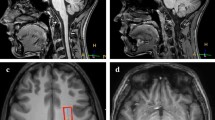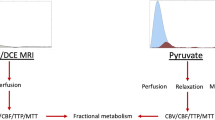Abstract
Gliomas can display marked changes in the concentrations of energy metabolism molecules such as creatine (Cr), phosphocreatine (PCr) and lactate, as measured using magnetic resonance spectroscopy (MRS). Moreover, the BOLD (blood oxygen level dependent) contrast enhancement in functional magnetic resonance imaging (fMRI) can be reduced or missing within or near gliomas, while neural activity is not significantly reduced (so-called neurovascular decoupling), so that the location of functionally eloquent areas using fMRI can be erroneous. In this paper, we adapt a previously developed model of the coupling between neural activation, energy metabolism and hemodynamics, by including the venous dilatation “Balloon model” of Buxton and Frank. We show that decreasing the cerebral blood flow (CBF) baseline value, or the CBF increase fraction, results in a decrease of the BOLD signal and an increase of the lactate peak during a sustained activation. Baseline lactate and PCr levels are not significantly affected by CBF baseline reduction, but are altered even by a moderate decrease of mitochondrial respiration. Decreasing the total Cr and PCr concentration reduces the BOLD signal after the initial overshoot. In conclusion, we suggest that the coupled use of BOLD fMRI and MRS could contribute to a better understanding of the neurovascular and metabolic decoupling in gliomas.
Similar content being viewed by others
REFERENCES
Ances, B.M., D.G. Buerk, J.H. Greenberg and J.A. Detre (2001). Temporal dynamics of the partial pressure of brain tissue oxygen during functional forepaw stimulation in rats. Neuroscience Letters 306: 106–110.
Aubert, A., R. Costalat and R. Valabrègue (2001). Modelling of the coupling between brain electrical activity and metabolism. Acta Biotheoretica 49: 301–326.
Buxton, R.B., E.C. Wong and L.R. Frank (1998a). Dynamics of blood flow and oxygenation changes during brain activation: the balloon model. Magnetic Resonance in Medicine 39: 855–864.
Buxton, R.B., K. Miller, L.R. Frank and E.C. Wong (1998b). BOLD signal dynamics: the balloon model with viscoelastic effects. Proceedings of the International Society for Magnetic Resonance in Medicine 6: 1401.
Disbrow, E.A., D.A. Slutsky, T.P.L. Roberts and L.A. Krubitzer (2000). Functional MRI at 1.5 tesla: a comparison of the blood oxygenation level-dependent signal and electrophysiology. Proceedings of the National Academy of Sciences of the United States 97: 9718–9723.
Duffau, H., L. Capelle, J. Sichez, T. Faillot, L. Abdennour, J.D. Law Koune, S. Dadoun, A. Bitar, F. Arthuis, R. van Effenterre and D. Fohanno (1999). Intra-operative direct electrical stimulations of the central nervous system: the Salpetriere experience with 60 patients. Acta Neurochirurgica (Wien) 141: 1157–67.
Duffau, H., L. Capelle, J. Sichez, D. Denvil, M. Lopes, J.P. Sichez, A. Bitar and D. Fohanno (2002). Intraoperative mapping of the subcortical language pathways using direct stimulations. An anatomo-functional study. Brain 125: 1–16.
Frahm, J., G. Krüger, K.D. Merboldt and A. Kleinschmidt (1996). Dynamic uncoupling and recoupling of perfusion and oxydative metabolism during focal brain activation in man. Magnetic Resonance in Medicine 35: 143–148.
Garcia-Martin, M.-L., G. Hérigault, C. Rémy, R. Farion, P. Ballesteros, J.A. Coles, S. Cerdan and A. Ziegler (2001). Mapping extracellular pH in rat brain gliomas in vivo by 1H Magnetic Resonance Spectroscopic Imaging: Comparison with maps of metabolites. Cancer Research 61: 6524–6531.
Gjedde, A. (1997). The relation between brain function and cerebral blood flow and metabolism. In: H.H. Batjer (ed.), Cerebral Disease, pp. 23–40. Philadelphia, Lippincott-Raven Publishers.
Gruetter, R., K. Ugurbil, and E.R. Seaquist (1998). Steady-state cerebral glucose concentrations and transport in the human brain. Journal of Neurochemistry 70: 397–408.
Heinrich, R. and S. Schuster (1996). The Regulation of Cellular Systems. ITP Chapman & Hall, New York.
Holodny, A.I., M. Schulder, W.-C. Liu, J.A. Maldjian and A.J. Kalnin (1999). Decreased BOLD functional MR activation of the motor and sensory cortices adjacent to a glioblastoma multiforme: implications for image-guided neurosurgery. American Journal of Neuroradiology 20: 609–612.
Holodny, A.I., M. Schulder, W.-C. Liu, J. Wolko, J.A. Maldjian and A.J. Kalnin (2000). The effect of brain tumors on BOLD functional MR Imaging activation in the adjacent motor cortex: implications for image-guided neurosurgery. American Journal of Neuroradiology 21: 1415–1422.
Jack, C.R. Jr., C.C. Lee, H.A. Ward and S.J. Riederer (1999). The role of functional MRI in planning perirolandic surgery. In: C.T.W. Moonen and P.A. Bandettini (eds.), Functional MRI, pp. 540–550. New-York, Springer.
Janny, P., H. Cure, M. Mohr, N. Heldt, F. Kwiatkowski, J.J. Lemaire, R. Plagne and R. Rozan (1994). Low grade supratentorial astrocytomas. Management and prognostic factors. Cancer 73: 1937–1945.
Kaibara, T., R.L. Tyson and G.R. Sutherland (1998). Human cerebral neoplasms studied using MR spectroscopy: a review. Biochemistry and Cell Biology 76: 477–486.
Keles, G.E., K.R. Lamborn and M.S. Berger (2001). Low-grade hemispheric gliomas in adults: a critical review of extent of resection as a factor influencing outcome. Journal of Neurosurgery 95: 735–745.
Korzeniewski, B. (2000). Regulation of ATP supply in mammalian skeletal muscle during resting state → intensive work transition. Biophysical Chemistry 83: 19–34.
Krüger, G., A. Kastrup, A. Takahashi and G.H. Glover (1999). Simultaneous monitoring of dynamic changes in cerebral blood flow and oxygenation during sustained activation of the human visual cortex. NeuroReport 10: 2939–2943.
Lehericy, S., H. Duffau, P. Cornu, L. Capelle, B. Pidoux, A. Carpentier, S. Auliac, S. Clemenceau, J.P. Sichez, A. Bitar, C.A. Valery, R. van Effenterre, T. Faillot, A. Srour, D. Fohanno, J. Philippon, D. Le Bihan and C. Marsault (2000). Correspondence between functional magnetic resonance imaging somatotopy and individual brain anatomy of the central region: comparison with intraoperative stimulation in patients with brain tumors. Journal of Neurosurgery 92: 589–598.
Magistretti, P.J. and L. Pellerin (2000). The astrocyte-mediated coupling between synaptic activity and energy metabolism operates through volume transmission. Progress in Brain Research 125: 229–240.
Mandeville, J.B., J.J.A. Marota, C. Ayata, G. Zaharchuk, M.A. Moskowitz, B.R. Rosen and R.M. Weisskoff (1999). Evidence of a cerebrovascular postarteriole windkessel with delayed compliance. Journal of Cerebral Blood Flow and Metabolism 19: 679–689.
Prichard, J., D. Rothman, E. Novotny, O. Petroff, T. Kuwabara, M. Avison, A. Howseman, C. Hanstock and R. Shulman (1991). Lactate rise detected by 1H NMR in human visual cortex during physiologic stimulation. Proceedings of the National Academy of Sciences of the United States 88: 5829–5831.
Schiffbauer, H., P. Ferrari, H.A. Rowley, M.S. Berger and T.P. Roberts (2001). Functional activity within brain tumors: a magnetic source imaging study. Neurosurgery 49: 1313–1320.
Schreiber, A., U. Hubbe, S. Ziyeh and J. Hennig (2000). The influence of gliomas and nonglial space-occupying lesions on blood-oxygen-level-dependent contrast enhancement. American Journal of Neuroradiology 21: 1055–1063.
Terpstra, M., W.B. High, Y. Luo, R.A. de Graaf, H. Merkle and M. Garwood (1996). Relationships among lactate concentration, blood flow and histopathologic profiles in rat C6 glioma. Nuclear Magnetic Resonance in Biomedicine 9: 185–194.
Terpstra, M., R. Gruetter, W.B. High, M. Mescher, L. DelaBarre, H. Merkle and M. Garwood (1998). Lactate turnover in rat glioma measured by in vivo nuclear magnetic resonance spectroscopy. Cancer Research 58: 5083–5088.
Toglia, A., J.M. Kittelson, R.B. Roemer, J.A. Hodak and L.P. Carter (1996). Cerebral blood flow in and around spontaneous malignant gliomas. International Journal of Hyperthermia 12: 461–476.
Vafaee, M.S. and A. Gjedde (2000). Model of blood-brain transfer of oxygen explains nonlinear flow-metabolism coupling during stimulation of visual cortex. Journal of Cerebral Blood Flow and Metabolism 20: 747–754.
Ziegler, A., M. von Kienlin, M. Décorps and C. Rémy (2001). High glycolytic activity in rat glioma demonstrated in vivo by correlation peak 1H Magnetic Resonance Imaging. Cancer Research 61: 5595–5600.
Author information
Authors and Affiliations
Rights and permissions
About this article
Cite this article
Aubert, A., Costalat, R., Duffau, H. et al. Modeling of Pathophysiological Coupling between Brain Electrical Activation, Energy Metabolism and Hemodynamics: Insights for the Interpretation of Intracerebral Tumor Imaging. Acta Biotheor 50, 281–295 (2002). https://doi.org/10.1023/A:1022620818701
Issue Date:
DOI: https://doi.org/10.1023/A:1022620818701




